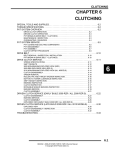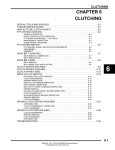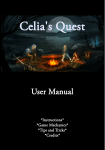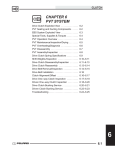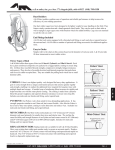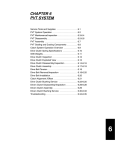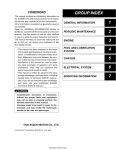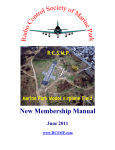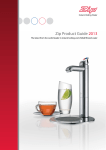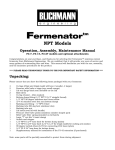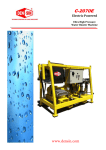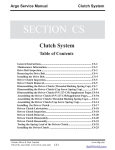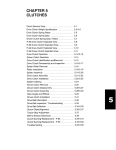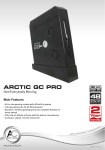Download Clutching (PVT) - the Polaris International Extranet
Transcript
CLUTCHING (PVT) CHAPTER 7 CLUTCHING (PVT) SPECIAL TOOLS AND SUPPLIES . . . . . . . . . . . . . . . . . . . . . . . . . . . . . . . . . . . . . . . . . . 7.2 TORQUE SPECIFICATIONS. . . . . . . . . . . . . . . . . . . . . . . . . . . . . . . . . . . . . . . . . . . . . . . 7.2 PVT SYSTEM OVERVIEW . . . . . . . . . . . . . . . . . . . . . . . . . . . . . . . . . . . . . . . . . . . . . . . . 7.2 GENERAL OPERATION. . . . . . . . . . . . . . . . . . . . . . . . . . . . . . . . . . . . . . . . . . . . . . . . . . 7.2 DRIVE CLUTCH OPERATION . . . . . . . . . . . . . . . . . . . . . . . . . . . . . . . . . . . . . . . . . . . . . 7.2 SHIFT WEIGHTS . . . . . . . . . . . . . . . . . . . . . . . . . . . . . . . . . . . . . . . . . . . . . . . . . . . . . . . 7.3 DRIVEN CLUTCH OPERATION. . . . . . . . . . . . . . . . . . . . . . . . . . . . . . . . . . . . . . . . . . . . 7.3 PVT BREAK-IN (DRIVE BELT / CLUTCHES) . . . . . . . . . . . . . . . . . . . . . . . . . . . . . . . . . 7.3 MAINTENANCE / INSPECTION. . . . . . . . . . . . . . . . . . . . . . . . . . . . . . . . . . . . . . . . . . . . 7.3 OVERHEATING / DIAGNOSIS. . . . . . . . . . . . . . . . . . . . . . . . . . . . . . . . . . . . . . . . . . . . . 7.4 PVT SYSTEM SERVICE . . . . . . . . . . . . . . . . . . . . . . . . . . . . . . . . . . . . . . . . . . . . . . . . . . 7.5 PVT SEALING AND DUCTING COMPONENTS . . . . . . . . . . . . . . . . . . . . . . . . . . . . . . . 7.5 PVT DISASSEMBLY (XP MODELS) . . . . . . . . . . . . . . . . . . . . . . . . . . . . . . . . . . . . . . . . 7.6 PVT DISASSEMBLY (X2 / TOURING MODELS) . . . . . . . . . . . . . . . . . . . . . . . . . . . . . . . 7.7 PVT ASSEMBLY. . . . . . . . . . . . . . . . . . . . . . . . . . . . . . . . . . . . . . . . . . . . . . . . . . . . . . . . 7.9 DRIVE BELT . . . . . . . . . . . . . . . . . . . . . . . . . . . . . . . . . . . . . . . . . . . . . . . . . . . . . . . . . . 7.11 BELT REMOVAL . . . . . . . . . . . . . . . . . . . . . . . . . . . . . . . . . . . . . . . . . . . . . . . . . . . . . . 7.11 BELT INSPECTION . . . . . . . . . . . . . . . . . . . . . . . . . . . . . . . . . . . . . . . . . . . . . . . . . . . . 7.12 BELT INSTALLATION . . . . . . . . . . . . . . . . . . . . . . . . . . . . . . . . . . . . . . . . . . . . . . . . . . 7.12 PVT BREAK-IN (DRIVE BELT / CLUTCHES) . . . . . . . . . . . . . . . . . . . . . . . . . . . . . . . . 7.13 DRIVE CLUTCH SERVICE . . . . . . . . . . . . . . . . . . . . . . . . . . . . . . . . . . . . . . . . . . . . . . . 7.14 SPRING SPECIFICATIONS . . . . . . . . . . . . . . . . . . . . . . . . . . . . . . . . . . . . . . . . . . . . . . 7.14 SHIFT WEIGHTS . . . . . . . . . . . . . . . . . . . . . . . . . . . . . . . . . . . . . . . . . . . . . . . . . . . . . . 7.15 EXPLODED VIEW . . . . . . . . . . . . . . . . . . . . . . . . . . . . . . . . . . . . . . . . . . . . . . . . . . . . . 7.15 CLUTCH DISASSEMBLY . . . . . . . . . . . . . . . . . . . . . . . . . . . . . . . . . . . . . . . . . . . . . . . . 7.16 SPIDER REMOVAL . . . . . . . . . . . . . . . . . . . . . . . . . . . . . . . . . . . . . . . . . . . . . . . . . . . . 7.16 ROLLER, PIN, AND THRUST WASHER INSPECTION. . . . . . . . . . . . . . . . . . . . . . . . . 7.17 BUTTON TO TOWER CLEARANCE INSPECTION. . . . . . . . . . . . . . . . . . . . . . . . . . . . 7.18 SHIFT WEIGHT INSPECTION . . . . . . . . . . . . . . . . . . . . . . . . . . . . . . . . . . . . . . . . . . . . 7.18 BEARING INSPECTION. . . . . . . . . . . . . . . . . . . . . . . . . . . . . . . . . . . . . . . . . . . . . . . . . 7.18 CLUTCH INSPECTION . . . . . . . . . . . . . . . . . . . . . . . . . . . . . . . . . . . . . . . . . . . . . . . . . 7.19 MOVEABLE SHEAVE BUSHING INSPECTION . . . . . . . . . . . . . . . . . . . . . . . . . . . . . . 7.20 BUSHING SERVICE. . . . . . . . . . . . . . . . . . . . . . . . . . . . . . . . . . . . . . . . . . . . . . . . . . . . 7.20 CLUTCH ASSEMBLY . . . . . . . . . . . . . . . . . . . . . . . . . . . . . . . . . . . . . . . . . . . . . . . . . . . 7.23 7 DRIVEN CLUTCH SERVICE . . . . . . . . . . . . . . . . . . . . . . . . . . . . . . . . . . . . . . . . . . . . . . 7.24 CLUTCH DISASSEMBLY . . . . . . . . . . . . . . . . . . . . . . . . . . . . . . . . . . . . . . . . . . . . . . . . 7.24 CLUTCH INSPECTION . . . . . . . . . . . . . . . . . . . . . . . . . . . . . . . . . . . . . . . . . . . . . . . . . 7.25 CLUTCH ASSEMBLY . . . . . . . . . . . . . . . . . . . . . . . . . . . . . . . . . . . . . . . . . . . . . . . . . . . 7.26 EXPLODED VIEW . . . . . . . . . . . . . . . . . . . . . . . . . . . . . . . . . . . . . . . . . . . . . . . . . . . . . 7.28 TROUBLESHOOTING. . . . . . . . . . . . . . . . . . . . . . . . . . . . . . . . . . . . . . . . . . . . . . . . . . . 7.29 7.1 9923067 - 2011 Sportsman 850 Service Manual © Copyright 2010 Polaris Sales Inc. CLUTCHING (PVT) SPECIAL TOOLS AND SUPPLIES TOOL DESCRIPTION PART NUMBER Drive Clutch Puller (Short) PA-48595 Clutch Holding Wrench 9314177 Clutch Holding Fixture 2871358-A Drive Clutch Spider Removal and Installation Tool 2870341 Roller Pin Tool 2870910 Clutch Bushing Replacement Tool Kit 2871226 Piston Pin Puller 2870386 Clutch Compression Tool 8700220 Clutch Bushing Replacement Tool Kit 2871025 PVT SYSTEM OVERVIEW General Operation WARNING All PVT maintenance or repairs should be performed by a certified Polaris Master Service Dealer (MSD) technician who has received the proper training and understands the procedures outlined in this manual. Because of the critical nature and precision balance incorporated into the PVT components, it is absolutely essential that no disassembly or repair be made without factory authorized special tools and service procedures. The Polaris Variable Transmission (PVT) consists of three major assemblies: 1) The Drive Clutch SPECIAL SUPPLIES PART NUMBER Loctite™ 242 Blue N/A 3) The Drive Belt Loctite™ 609 Green N/A RTV Silicone Sealer 8560054 The internal components of the drive clutch and driven clutch control engagement (initial vehicle movement), clutch upshift and backshift. During the development of a Polaris ATV, the PVT system is matched first to the engine power curve; then to average riding conditions and the vehicle’s intended usage. Therefore, modifications or variations of components at random are never recommended. Proper clutch setup and careful inspection of existing components must be the primary objective when troubleshooting and tuning. TORQUE SPECIFICATIONS PVT System Fastener Torques ITEM TORQUE VALUE Drive Clutch Spider 200 ft. lbs. (271 Nm) Drive Clutch Retaining Bolt 47 ft. lbs. (64 Nm) Left Hand Thread Driven Clutch Retaining Bolt 37 ft. lbs. (50 Nm) Drive Clutch Cover Bolts 100 in. lbs. (11 Nm) Inner PVT Cover Screws 6-8 ft. lbs. (8-11 Nm) Outer PVT Cover Screws 45-50 in. lbs. (5-5.6 Nm) Drive Clutch Weight Pins 15-25 in. lbs. (2-3 Nm) 2) The Driven Clutch Drive Clutch Operation Drive clutches primarily sense engine RPM. The two major components which control its shifting function are the shift weights and the coil spring. Whenever engine RPM is increased, centrifugal force is created, causing the shift weights to push against rollers on the moveable sheave, which is held open by coil spring preload. When this force becomes higher than the preload in the spring, the outer sheave moves inward and contacts the drive belt. This motion pinches the drive belt between the spinning sheaves and causes it to rotate, which in turn rotates the driven clutch. At lower RPM, the drive belt rotates low in the drive clutch sheaves. As engine RPM increases, centrifugal force causes the drive belt to be forced upward on drive clutch sheaves. 7.2 9923067 - 2011 Sportsman 850 Service Manual © Copyright 2010 Polaris Sales Inc. CLUTCHING (PVT) Shift Weights Maintenance / Inspection Shift weights have many factors designed into them for controlling engagement RPM and shifting patterns. Shift weights should not be changed or altered without first having a thorough understanding of their positioning and the effects they may have on belt to sheave clearance, clutch balance and shifting pattern. Under normal use the PVT system will provide years of trouble free operation. Periodic inspection and maintenance is required to keep the system operating at peak performance. The following list of items should be inspected and maintained to ensure maximum performance and service life of PVT components. Refer to the troubleshooting checklist at the end of this chapter for more information. Driven Clutch Operation • Belt Inspection Driven clutches primarily sense torque, opening and closing according to the forces applied to it from the drive belt and the transmission input shaft. If the torque resistance at the transmission input shaft is greater than the load from the drive belt, the drive belt is kept at the outer diameter of the driven clutch sheaves. As engine RPM and horsepower increase, the load from the drive belt increases, resulting in the belt rotating up toward the outer diameter of the drive clutch sheaves and downward into the sheaves of the driven clutch. This action, which increases the driven clutch speed, is called upshifting. Should the throttle setting remain the same and the vehicle is subjected to a heavier load, the drive belt rotates back up toward the outer diameter of the driven clutch and downward into the sheaves of the drive clutch. This action, which decreases the driven clutch speed, is called backshifting. In situations where loads vary (such as uphill and downhill) and throttle settings are constant, the drive and driven clutches are continually shifting to maintain optimum engine RPM. At full throttle a perfectly matched PVT system should hold engine RPM at the peak of the power curve. This RPM should be maintained during clutch upshift and backshift. In this respect, the PVT system is similar to a power governor. Rather than vary throttle position, as a conventional governor does, the PVT system changes engine load requirements by either upshifting or backshifting. • Drive and Driven Clutch Buttons and Bushings • Drive Clutch Shift Weights and Pins • Drive Clutch Spider Rollers and Roller Pins • Drive and Driven Clutch Springs • Sheave Faces (clean and inspect for wear) • PVT System Sealing. Refer to appropriate illustrations on the following pages. The PVT system is air cooled by fins on the drive clutch stationary sheave. The fins create a low pressure area in the crankcase casting, drawing air into the system through an intake duct. The opening for this intake duct is located at a high point on the vehicle (location varies by model). The intake duct draws fresh air through a vented cover. All connecting air ducts (as well as the PVT cover) must be properly sealed to ensure clean air is being used for cooling the PVT system and also to prevent water and other contaminants from entering the PVT area. This is especially critical on units subjected to frequent water forging. PVT Break-In (Drive Belt / Clutches) A proper break-in of the clutches and drive belt will ensure a longer life and better performance. Break in the clutches and drive belt by operating at slower speeds during the 10 hour break-in period as recommended (see Chapter 5 “Engine Break-In Period” for break-in example). Pull only light loads. Avoid aggressive acceleration and high speed operation during the break-in period. 7.3 9923067 - 2011 Sportsman 850 Service Manual © Copyright 2010 Polaris Sales Inc. 7 CLUTCHING (PVT) Overheating / Diagnosis During routine maintenance, or whenever PVT system overheating is evident, it’s important to check the inlet and outlet ducting for obstructions. Obstructions to air flow through the ducts will significantly increase PVT system operating temperatures. The vehicle should be operated in Low when plowing or pulling heavy loads, or if extended low speed operation is anticipated. CLUTCH DRIVE BELT & COVER RELATED ISSUES: DIAGNOSIS Possible Causes Loading the vehicle into a truck or tall trailer when in high range. Solutions / What to do Shift transmission to Low during loading of the vehicle to prevent belt burning. Starting out going up a steep incline from When starting out on an incline, use Low, or dismount the vehicle after first a stopped position. applying the park brake and perform the “K” turn. Driving at low RPM or low ground speed Drive at higher speed or use Low. The use of Low is highly recommended for (at approximately 3-7 MPH). cooler PVT operating temperatures and longer component life. Insufficient engine warm-up when exposed to low ambient temperatures. Warm engine at least 5 min., then with transmission in neutral, advance throttle to approx. 1/8 throttle in short bursts, 5 to 7 times. The belt will become more flexible and prevent belt burning. Slow and easy clutch engagement. Fast, effective use of the throttle for efficient engagement. Towing/Pushing at low RPM/low ground Use Low only. speed. Plowing snow, dirt, etc./utility use. Use Low only. Stuck in mud or snow. Shift the transmission to Low, carefully use fast, aggressive throttle application to engage clutch. WARNING: Excessive throttle may cause loss of control and vehicle overturn. Climbing over large objects from a stopped position. Shift the transmission to Low, carefully use fast, aggressive, brief throttle application to engage clutch. WARNING: Excessive throttle may cause loss of control and vehicle overturn. Belt slippage from water or snow ingestion into the PVT system. Shift the transmission to neutral. Using the throttle, vary the engine rpm from idle to full throttle. Repeat several times as required. During this procedure, the throttle should not be held at the full position for more than 10 seconds. Clutch seals should be inspected for damage if repeated leaking occurs. Clutch malfunction. For inspection of clutch components, please contact your Polaris dealer. Shift transmission to Low during loading of the vehicle to prevent belt burning. Poor engine performance. Fouled plugs, foreign material in gas tank, fuel lines, or carburetor. Contact you dealer for further service information. GENERAL RANGE OPERATION GUIDELINES: Low: Heavy pulling, basic operational speeds less than 7 MPH, riding through rough terrain (swamps, mountains, ect.), low ground speeds. High: High ground speeds, speeds above 7 MPH. IMPORTANT: Using High Gear when pulling heavy loads, operating on hilly terrain, or in wet, muddy conditions will increase the chance of drive belt damage. 7.4 9923067 - 2011 Sportsman 850 Service Manual © Copyright 2010 Polaris Sales Inc. CLUTCHING (PVT) PVT SYSTEM SERVICE PVT Sealing and Ducting Components Cover Screws Outer PVT Cover Clamps Outer Seal Air Inlet Duct Drain Plug Boot O-Ring Screws Boot Outlet Duct Inner PVT Cover 7 Boot Clamps 7.5 9923067 - 2011 Sportsman 850 Service Manual © Copyright 2010 Polaris Sales Inc. CLUTCHING (PVT) PVT Disassembly (XP Models) 6. With the belt removed, completely remove the retaining bolt and driven clutch. 7. Install the Drive Clutch Holder (PN 9314177) onto the drive clutch. Some fasteners and procedures will vary. Refer to the appropriate parts manual for proper fastener placement. 1. Remove the seat. 2. Remove the (10) push rivets and (4) Torx-headed screws retaining the rear cab assembly. Drive Clutch Holder (9314177) 8. 3. Remove the tail light bulbs from the tail lamps, disconnect the tail light harnesses from the rear cab, and remove the rear cab to allow access to the PVT system for disassembly. 4. Remove the left rear wheel, lower LH frame support, outer PVT cover and drive belt. Refer to “Belt Removal (XP Models)”. 5. Loosen the clamps, remove the push rivet and remove the PVT outlet duct from the inner PVT cover. Remove the duct from the vehicle. Remove the drive clutch retaining bolt by turning the bolt in a clockwise direction. NOTE: The drive clutch retaining bolt has left-hand threads. Turn the bolt clockwise to remove it. 7.6 9923067 - 2011 Sportsman 850 Service Manual © Copyright 2010 Polaris Sales Inc. CLUTCHING (PVT) 9. Insert the Drive Clutch Puller (PA-48595) into the drive clutch and use it to remove the clutch from the shaft. PVT Disassembly (X2 / TOURING Models) Some fasteners and procedures will vary. Refer to the appropriate parts manual for proper fastener placement. 1. Remove the driver’s seat and rear fenders (X2) or rear cab assembly (TOURING). X2 Models PA-48595 • Tilt the rear cargo box open and remove the seat. • Remove the (8) push rivets retaining each rear fender. Drive Clutch Puller ( PA-48595) 10. If removing the inner PVT cover, continue with this procedure. 11. Remove the (10) screws that retain the inner PVT cover to the transmission case and remove the cover. 7 TOURING Models • Remove the rear passenger seat. Inner PVT Cover • Remove the (12) push rivets and (4) bolts retaining the rear cab assembly. 12. Remove the old silicone material from the inner PVT cover and transmission case using a wire brush. Clean both surfaces thoroughly in preparation for assembly. 7.7 9923067 - 2011 Sportsman 850 Service Manual © Copyright 2010 Polaris Sales Inc. CLUTCHING (PVT) • Remove the tail light bulbs from the tail lamps, disconnect the tail light harnesses from the rear cab, and remove the rear cab to allow access to the PVT system for disassembly. 2. Remove the rear skid plate, outer PVT cover and drive belt. Refer to “Belt Removal (X2 / TOURING Models)”. 3. Loosen the clamps, remove the push rivet and remove the PVT outlet duct from the inner PVT cover. 7. Remove the drive clutch retaining bolt by turning the bolt in a clockwise direction. NOTE: The drive clutch retaining bolt has left-hand threads. Turn the bolt clockwise to remove it. 8. 4. 5. Insert the Drive Clutch Puller (PA-48595) into the drive clutch and use it to remove the clutch from the shaft. Remove the PVT outlet duct from the vehicle to allow for driven clutch removal. Remove the duct through the bottom of the frame in the same manner as the outer PVT cover. With the belt removed, completely remove the retaining bolt and driven clutch. PA-48595 Drive Clutch Puller ( PA-48595) 9. 6. Remove the drive clutch through the bottom of the frame. Install the Drive Clutch Holder (PN 9314177) onto the drive clutch. Drive Clutch Holder (9314177) 7.8 9923067 - 2011 Sportsman 850 Service Manual © Copyright 2010 Polaris Sales Inc. CLUTCHING (PVT) 10. Remove the (10) screws that retain the inner PVT cover to the transmission case and remove the cover. 4. Install the cover and torque the inner PVT cover screws to specification. =T Inner PVT Cover Screws: 6-8 ft. lbs. (8-11 Nm) Inner PVT Cover 5. Wipe away any excess silicone sealant. 6. Clean end of taper on crankshaft and the taper bore inside drive clutch using a tapered reamer. 7. Install the drive clutch, bushing, washer, lock washer, and the left-hand threaded retaining bolt. Torque retaining bolt to specification. 11. Remove the old silicone material from the inner PVT cover and transmission case using a wire brush. Clean both surfaces thoroughly in preparation for assembly. =T Drive Clutch Retaining Bolt: 47 ft. lbs. (64 Nm) PVT Assembly 1. 2. 3. Inspect the inner PVT cover. Replace if cracked or damaged. The mating surface must be clean to ensure adhesion of new silicone sealant. Be sure to “flame treat” the inner PVT cover prior to applying silicone to ensure good adhesion. Pass the flame of a propane torch back and forth quickly over the area where the silicone is to be applied (2-3 inches from the flame tip is recommended). Do not hold the torch too close to the surface. Keep the torch moving to prevent damage. 8. Clean the splines on the transmission input shaft and apply a light film of grease to the splines on the shaft. 9. Install the driven clutch, thrust washer, flat washers and retaining bolt in the order shown. 7 Flat Washers (4) .120” Flat Washer .190” Apply RTV silicone sealant to the outside edge of the inner PVT cover to ensure a water tight fit between the cover and the transmission. Flat Washer .160” Thrust Washer .060” 10. Install drive belt noting direction of rotation if the belt is being reused. Refer to “Belt Installation”. 11. Torque the driven clutch retaining bolt to specification =T Driven Clutch Retaining Bolt: 37 ft. lbs. (50 Nm) NOTE: While tightening the retaining bolt, stop and rotate the driven clutch counter-clockwise a few times to prevent the belt from binding in the clutch. 7.9 9923067 - 2011 Sportsman 850 Service Manual © Copyright 2010 Polaris Sales Inc. CLUTCHING (PVT) XP Models 12. Install the PVT outlet duct and align it with the inner PVT cover. Install the push rivet and tighten the hose clamps to 12-16 in. lbs. (1.4-1.8 Nm). Push Rivet =T Lower Left-Hand Frame Support Bolts: 36 ft. lbs. (49 Nm) 17. Install the left rear wheel and torque wheel nuts to specification. =T Wheel Nuts: Steel: 45 ft. lbs. (61 Nm) Aluminum: 75 ft. lbs. (102 Nm) Tighten Clamps 18. Reinstall the seat, lower the ATV, start the engine and test the operation of the PVT system. X2 / TOURING Models NOTE: Be sure the rubber storage box shield is resting on top of the outlet duct as shown so it does not obstruct air flow. Rubber Shield 19. Install the PVT outlet duct and align it with the inner PVT cover. Install the push rivet and tighten the hose clamps to 12-16 in. lbs. (1.4-1.8 Nm). Push Rivet Tighten Clamps 13. Replace the outer PVT cover seal. 20. Replace the outer PVT cover seal. 14. Reinstall outer PVT cover and secure with screws. Torque screws to specification. 21. Reinstall outer PVT cover and secure with screws. Torque screws to specification. =T =T Outer PVT Cover Screws: 45-50 in. lbs. (5-5.6 Nm) Outer PVT Cover Screws: 45-50 in. lbs. (5-5.6 Nm) 15. Reinstall the rear cab, tail light bulbs, and fasteners. 22. Reinstall rear skid plate and (6) T40 Torx-headed screws. 16. Reinstall the lower left-hand frame support and torque bolts to specification. 23. Reinstall the rear fenders (X2) or rear cab (TOURING), tail light bulbs, and fasteners. 24. Reinstall the seat(s), start the engine and test the operation of the PVT system. 7.10 9923067 - 2011 Sportsman 850 Service Manual © Copyright 2010 Polaris Sales Inc. CLUTCHING (PVT) DRIVE BELT Belt Removal (XP Models) 1. Position the vehicle on a level surface and place the transmission in Park. 2. Elevate and safely support the rear of the vehicle. 3. Remove the left rear wheel from the vehicle. 4. Remove the (4) bolts retaining the lower left-hand frame support and remove it from the frame. 8. Note the orientation of the drive belt so that it can be installed in the same direction. 9. Loosen the driven clutch retaining bolt to allow the clutch sheaves to open. Loosen 10. Walk the belt out of the driven clutch and drive clutch, and remove it from the vehicle. Belt Removal (X2 / TOURING Models) Frame Support 5. Remove the seat. 6. Remove the (11) screws retaining the PVT cover. 7. 1. Position the vehicle on a level surface and place the transmission in Park. 2. Remove the (6) T40 Torx-headed screws retaining the rear skid plate and remove the skid plate from under the vehicle. 3. Remove the driver’s seat. 4. Remove the (11) screws retaining the PVT cover. Using care, pull the outer PVT cover out the left-hand wheel well. 7.11 9923067 - 2011 Sportsman 850 Service Manual © Copyright 2010 Polaris Sales Inc. 7 CLUTCHING (PVT) 5. Using care, pull the outer PVT cover through the bottom of the frame. Belt Inspection 1. Inspect belt for hour glassing (extreme circular wear in at least one spot and on both sides of the belt). Hour glassing occurs when the drive train does not move and the drive clutch engages the belt. 2. Inspect belt for loose cords, missing cogs, cracks, abrasions, thin spots, or excessive wear. Compare belt measurements with a new drive belt. Replace if necessary. 3. Belts with thin spots, burn marks, etc., should be replaced to eliminate noise, vibration, or erratic PVT operation. See the Troubleshooting Chart at the end of this chapter for possible causes. Belt Installation NOTE: Be sure to move the rear brake line out of the way upon removal to prevent from catching it with the outer PVT cover. 6. Note the orientation of the drive belt so that it can be installed in the same direction. 7. Loosen the driven clutch retaining bolt to allow the clutch sheaves to open. 1. Loop the belt over the drive clutch and over top of the driven clutch sheaves. Loosen NOTE: If reusing the drive belt, be sure to reinstall the belt in the same direction as it was removed. 2. 8. Torque the driven clutch retaining bolt to specification. =T Walk the belt out of the driven clutch and drive clutch, and remove it from the vehicle. Driven Clutch Retaining Bolt: 37 ft. lbs. (50 Nm) NOTE: While tightening the retaining bolt, stop and rotate the driven clutch counter-clockwise a few times to prevent the belt from binding in the clutch. 3. Replace the outer PVT cover seal. 7.12 9923067 - 2011 Sportsman 850 Service Manual © Copyright 2010 Polaris Sales Inc. CLUTCHING (PVT) 4. Reinstall outer PVT cover and secure with screws. Torque screws to specification. =T Outer PVT Cover Screws: 45-50 in. lbs. (5-5.6 Nm) PVT Break-In (Drive Belt / Clutches) A proper break-in of the clutches and drive belt will ensure a longer life and better performance. Break in the clutches and drive belt by operating at slower speeds during the 10 hour break-in period as recommended (see Chapter 5 “Engine Break-In Period” for break-in example). Pull only light loads. Avoid aggressive acceleration and high speed operation during the break-in period. XP Models 5. Reinstall the lower left-hand frame support and torque bolts to specification. =T Lower Left-Hand Frame Support Bolts: 36 ft. lbs. (49 Nm) 6. Install rear wheel and torque wheel nuts to specification. =T Wheel Nuts: Steel: 45 ft. lbs. (61 Nm) Aluminum: 75 ft. lbs. (102 Nm) 7. 7 Install the seat, lower the ATV, start the engine and test the operation of the PVT system. X2 / TOURING Models 8. Reinstall the rear skid plate and the (6) T40 Torx-headed screws. 9. Install the seat, start the engine and test the operation of the PVT system. 7.13 9923067 - 2011 Sportsman 850 Service Manual © Copyright 2010 Polaris Sales Inc. CLUTCHING (PVT) DRIVE CLUTCH SERVICE Spring Specifications The drive clutch spring has two primary functions: 1. To control clutch engagement RPM. The springs, which have a higher rate when the clutch is in neutral, will increase clutch engagement RPM. 2. To control the rate at which the drive belt moves upward in the drive clutch sheaves. This is referred to as drive clutch upshift. Red/White 7043349 Red/Black 7043500 Red/Blue 7043372 There are other components which control upshift, but the spring is one of the primary components in insuring optimum performance. It is very important that the spring is of the correct design and is in good condition. Red/Green 7043382 CAUTION Never shim a drive clutch spring to increase its compression rate. This may result in complete stacking of the coils and subsequent clutch cover failure. The drive clutch spring is one of the most critical components of the PVT system. It is also one of the easiest to service. Due to the severe relaxation the spring is subject to during operation, it should always be inspected for tolerance limits during any clutch operation diagnosis or repair. With the spring resting on a flat surface, measure its free length from the outer coil surfaces as shown. Refer to the spring specification chart for specific free length measurements and tolerances. Also check to see that spring coils are parallel to one another. Distortion of the spring indicates stress fatigue, requiring replacement. Primary Clutch Springs PART NUMBER COLOR CODE WIRE DIAMETER FREE LENGTH ± .125” PART NUMBER COLOR CODE WIRE DIAMETER FREE LENGTH ± .125” 7041021 Plain .157" 4.38" 7041168 Green .177" 3.05" 7041022 Black .140" 4.25" 7043349 Red / White .200" 2.58" 7041063 Purple .168" 4.37" 7043372 Red / Blue .187" 2.56" 7041132 White .177" 2.92" 7043382 Red / Green .177" 2.63" 7041157 Blue / Green .177" 2.53" 7043500 Red / Black .200" 2.82" 7.14 9923067 - 2011 Sportsman 850 Service Manual © Copyright 2010 Polaris Sales Inc. CLUTCHING (PVT) Shift Weights Shown below are the shift weights which have been designed for this PVT system. These shift weights have many factors designed into them for controlling engagement RPM and shifting patterns. Shift weights should not be changed or altered without first having a thorough understanding of their positioning and the effects they may have on belt to sheave clearance, clutch balance and shifting pattern. Exploded View Bushing Spring Buttons Lock Washer 7 Washers Bolt Bearing One-Way Bearing Roller Cover Bolts Spacer Nut Pin Flat Washer Cover Bearing Spider Limiter Bolt Washers Shift Weight 7.15 9923067 - 2011 Sportsman 850 Service Manual © Copyright 2010 Polaris Sales Inc. CLUTCHING (PVT) Clutch Disassembly 1. 5. Using a permanent marker, mark the cover, spider, and moveable and stationary sheaves for reference, as the cast in X's may not have been in alignment before disassembly. Inspect Shaft 6. 2. Inspect area on shaft where bushing rides for wear, galling, nicks, or scratches. Replace clutch if worn or damaged. Remove and inspect the clutch spring. See “Drive Clutch Spring Specifications” for spring inspection. Mark the stationary sheave and clutch shaft to verify the shaft has not turned in the sheave after tightening the spider during clutch assembly. Spider Removal 1. Remove the limiter spacer from the shaft. 3. Remove cover bolts evenly in a cross pattern and remove cover plate. 2. 4. Inspect cover bushing (A). The outer cover bushing is manufactured with a Teflon coating. Wear is determined by the amount of Teflon remaining on the bushing. Install clutch in holding fixture (PN 2871358-A). NOTE: This updated holding fixture is required to fit the new drive clutch with a curved rib design. A 2871358-A 3. Loosen the spider (clockwise) using Clutch Spider Removal Tool (PN 2870341). IMPORTANT: The clutch shaft has left-hand threads. Be sure to turn the Spider Removal Tool in a clockwise direction to remove. Cover Bushing Inspection: Replace the cover bushing if more brass than Teflon is visible on the bushing. Refer to bushing replacement in this chapter. 2870341 7.16 9923067 - 2011 Sportsman 850 Service Manual © Copyright 2010 Polaris Sales Inc. CLUTCHING (PVT) NOTE: It is important that the same number and thickness of washers are reinstalled beneath the spider during assembly. Be sure to note the number and thickness of these washers. Roller, Pin, and Thrust Washer Inspection 1. Inspect all rollers, bushings and roller pins by pulling a flat metal rod across the roller. Turn roller with your finger. If you notice resistance, galling, or flat spots, replace rollers, pins and thrust washers in sets of three. Also inspect to see if roller and bushing are separating. Bushing must fit tightly in roller. Use the Roller Pin Tool (PN 2870910) to replace rollers and pins. Take care not to damage roller bushing or bearing surface of the new pin during installation. 2. Rubber backed buttons can be used in all clutches if the hollow roller pin is changed to the solid roller pin. To maintain proper clutch balance and belt-to-sheave clearance, be sure to reinstall original quantity and thickness washers. Moveable Sheave Bushing Inspection 4. Inspect the Teflon™ coating on the moveable sheave bushing. NOTE: The rubber side of the button is positioned toward the solid roller pin. TeflonTM Moveable Sheave Bushing Inspection: Replace the cover bushing if more brass than Teflon is visible on the bushing. Refer to bushing replacement in this chapter. 7.17 9923067 - 2011 Sportsman 850 Service Manual © Copyright 2010 Polaris Sales Inc. 7 CLUTCHING (PVT) Button To Tower Clearance Inspection 1. 2. Inspect for any clearance between spider button to tower. If clearance exists, replace all buttons and inspect surface of towers. See “Spider Removal” procedure. Remove shift weight bolts and weights. Inspect the contact surface of the weight. The surface should be smooth and free of dents or gall marks. Inspect the weight pivot bore and pivot bolts for wear or galling. If weights or bolts are worn or broken, replace in sets of three with new bolts. NOTE: A damaged shift weight is usually caused by a damaged or stuck roller in the spider assembly. See “Roller, Pin and Thrust Washer Inspection”. Bearing Inspection Button to Tower Clearance: 000-.005” 2. 1. Rotate the clutch bearing in both clockwise and counterclockwise directions. The one-way bearing should rotate counter-clockwise (when viewed from cover plate side) with only a slight amount of drag. When rotated clockwise the one-way bearing should lock to the shaft without slipping. 2. Verify there is no binding or rough spots. If problems are noted continue with disassembly. Inspect sheave surfaces. Replace the entire clutch if worn, damaged or cracked. Shift Weight Inspection WARNING The clutch assembly is a precisely balanced unit. Never replace parts with used parts from another clutch assembly! 1. If clutch is not disassembled, inspect as shown, using a clutch holding tool to compress the moveable sheave. The contact surface of the weight should be smooth and free of dents or gall marks. 7.18 9923067 - 2011 Sportsman 850 Service Manual © Copyright 2010 Polaris Sales Inc. CLUTCHING (PVT) Clutch Inspection 5. NOTE: Remove cover, spring, and spider following instructions for drive clutch removal, then proceed as follows: 1. Remove the moveable sheave spacer sleeve (1) and the thrust washer (2). Visually inspect the washer for damage. 2. Measure the thickness and compare to specification. Replace if worn or damaged. Inspect surface of shaft for pitting, grooves, or damage. Measure the outside diameter and compare to specifications. Replace the drive clutch assembly if shaft is worn or damaged. 1 2 = In. / mm. Thickness of spacer may differ from what is shown Shaft Diameter: Standard: 1.3745 - 1.375 (34.91 - 34.93 mm) Service Limit: 1.373” (34.87 mm) = In. / mm. 6. Thrust Washer Thickness Standard: .030” (.76 mm) Service Limit: .025” (.64 mm) Visually inspect PTFE thrust washer for damage. Measure the thickness and compare to specification. Replace if worn or damaged. = In. / mm. 3. Remove the moveable clutch sheave. 4. Lift bearing (3) and thrust washer (4) off shaft. Replace as an assembly if worn, damaged, or if problems were noted. PTFE Washer Thickness Standard: .030” (.76 mm) Service Limit: .025” (.64 mm) 3 4 Size of bearing may differ from what is shown 7.19 9923067 - 2011 Sportsman 850 Service Manual © Copyright 2010 Polaris Sales Inc. 7 CLUTCHING (PVT) Moveable Sheave Bushing Inspection Bushing Service Inspect the Teflon coating (arrow) on the moveable sheave bushing. Inspect both sheaves for signs of wear, grooving or cracking. De-glaze sheave surfaces with a 3M Scotch-Brite Pad if needed. IMPORTANT: Special Tools Required EBS Clutch Bushing Tool Kit - 2201379 Item A, B C D Qty. 1 1 1 Part # 5132027 5132501 5132029 1 Part Description EBS Puller Tool EBS Puller Nut EBS Main Adapter EBS Bushing Removal Tool E -- 1 Instructions 9915111 5132028 Additional Special Tools Qty. 1 1 Part Description Clutch Bushing Replacement Tool Kit Piston Pin Puller Part # 2871226 2870386 *Clutch Bushing Replacement Tool Kit (PN 2871226) Moveable Sheave Bushing Inspection: Replace the cover bushing if more brass than Teflon is visible on the bushing. Refer to bushing replacement in this chapter. #2 #3 #5 #10 #9 #8 Item Qty. #2 1 #3 1 #5 1 #8 #9 1 1 #10 1 Part Description P-90 Drive/Driven Clutch Bushing Install Tool Drive Clutch Cover Bushing Removal/ Installation Tool (all clutches) P-90 Driven Clutch Cover Bushing Removal Tool Main Puller Adapter Adapter Reducer Number Two Puller Adapter Part # 5020628 5020629 5020631 5020632 5010279 5020633 NOTE: Bushings are installed at the factory using Loctite 609. In order to remove bushings it will be necessary to apply heat evenly to the area around each bushing. Clean all residual Loctite from bushing bore prior to installing new bushing. 7.20 9923067 - 2011 Sportsman 850 Service Manual © Copyright 2010 Polaris Sales Inc. CLUTCHING (PVT) NOTE: Use Bushing Tool PA-47336. CAUTION 8. Install nut (C) onto end of puller rod and hand tighten. Turn puller barrel to increase tension on sheave if needed. Using a hand held propane torch, apply heat around outside of bushing until tiny smoke tailings appear. 9. Turn sheave counterclockwise on puller rod until it comes free. Lift sheave off puller. Clutch components will be hot! In order to avoid serious burns, wear insulated gloves during the removal process. Moveable Sheave - Bushing Removal 1. Remove clutch as outlined previously in this chapter. 10. Remove nut from puller rod and set aside. 2. Install handle end of the Piston Pin Puller (PN 2870386) securely into bench vise and lightly grease puller threads. 11. Pull bushing removal tool and adapter from puller rod. Remove bushing from tool and discard. Piston Pin Puller (PN 2870386) Drive Clutch Bushing Installation 1. 3. Place main adapter (Item 8) on puller. Puller Tool (A,B) Side “A” toward sheave Remove nut from puller rod and set aside. Nut (C) Piston Pin Puller (PN 2870386) Bushing Main Puller Adaptor (#8) (PN 5020632) Main Adapter (8) 4. Install puller adapter (Item 10 from kit PN 2871226). 5. Install main adapter (Item D) onto puller. Puller Tool (A,B) Side “A” toward sheave Main Adapter (D) 6. 7. Piston Pin Puller 2. Apply Loctite 609 evenly to bushing bore inside moveable sheave. 3. Set bushing in place on sheave. 4. Insert installation puller tool (Item A/B) with “A” side down, into center of bushing. NOTE: Some models use Bushing Tool PA-47336. 5. With towers pointing upward, slide sheave, bushing and tool onto puller rod. Puller Adapter (10) 6. Install nut on puller rod and hand tighten. Turn barrel to apply additional tension if needed. Piston Pin Puller 7. Turn sheave counterclockwise, making sure bushing is drawn straight into bore. Continue until bushing is seated. 8. Remove nut from puller rod and set aside. 9. Remove sheave from puller. Nut (C) With towers pointing toward the vise, slide sheave onto puller rod. Install removal tool (Item A, B) into center of sheave with “A side" toward sheave. 10. Remove installation tool. 7.21 9923067 - 2011 Sportsman 850 Service Manual © Copyright 2010 Polaris Sales Inc. 7 CLUTCHING (PVT) Cover Bushing Removal 1. Install main adapter (Item 8) on puller. Removal Tool (3) Nut (C) Adapter Reducer (9) Main Adapter (8) Piston Pin Puller 2. Install adapter reducer (Item 9). 3. From outside of clutch cover, insert removal tool (Item 3) into cover bushing. 4. With inside of cover toward vise, slide cover onto puller. 5. Install nut onto puller rod and hand tighten. Turn puller barrel to increase tension as needed. 6. Turn clutch cover counterclockwise on puller rod until bushing is removed and cover comes free. 7. Remove nut from puller rod and set aside. 8. Remove bushing and bushing removal tool from puller. Discard bushing. Cover Bushing Installation 1. Apply Loctite 609 evenly to bushing bore in cover. 2. Working from inside of cover, insert new bushing and bushing installation tool into center of clutch cover. 3. With main adapter on puller, insert cover onto puller rod, placing outside of cover toward vise. 4. Install nut on rod and hand tighten. Turn puller barrel to apply more tension if needed. 5. Turn clutch cover counterclockwise on puller rod until bushing is seated. 6. Remove nut from puller rod. Take installation tool and clutch cover off rod. 7.22 9923067 - 2011 Sportsman 850 Service Manual © Copyright 2010 Polaris Sales Inc. CLUTCHING (PVT) Clutch Assembly 4. NOTE: It is important that the same number and thickness of washers are reinstalled beneath the spider during assembly. The Teflon bushings are self-lubricating. Torque the spider (counter-clockwise) to specification using the holding fixture and spider tool. Torque with smooth motion to avoid damage to the stationary sheave. IMPORTANT: The clutch shaft has left-hand threads. Be sure to turn the Spider Removal Tool in a counterclockwise direction to reinstall. CAUTION =T Do not apply oil or grease to the bushings. Spider Torque: 200 ft. lbs. (271 Nm) Reassemble the drive clutch in the sequence provided below. Be sure the “X”, or the marks that were made earlier are aligned during each phase of assembly. CAUTION Be sure the spider spacer washers are fully seated in the recessed area in the spider. Any misalignment will alter clutch balance. Inverting the clutch while initially tightening the spider will help position the washers. 1. Install moveable sheave onto fixed sheave. 2. Install spider spacers. Use same quantity and thickness as were removed. 5. Install the limiter spacer over the shaft and on top of spider. 6. Install shift weights using new lock nuts on the bolts. 7 Use new lock nuts Spacer washers 3. Compress spider buttons for each tower and install spider, making sure that “X”, or the marks that were made earlier, on spider aligns with “X”, or the marks that were made earlier, in moveable sheave. 7. Reinstall clutch spring. 8. Reinstall cover, aligning “X” mark with other marks. 9. Torque cover bolts evenly to specification. =T Cover Bolt Torque: 100 in. lbs. (11 Nm) 7.23 9923067 - 2011 Sportsman 850 Service Manual © Copyright 2010 Polaris Sales Inc. CLUTCHING (PVT) DRIVEN CLUTCH SERVICE 5. Turn the compression tool handle counter-clockwise to relieve spring pressure and allow the cam (helix) to move out from the moveable sheave. 6. Remove the cam (helix), spider and compression spring from the clutch. Clutch Disassembly 1. Remove driven clutch from the transmission input shaft (see “PVT Disassembly”) 2. It is important to mark the position of the cam (helix) and sheave before disassembly or use the “X” marks on the components for reference. This will aid in reassembly and helps maintain clutch balance after reassembly. 3. Place the driven clutch into the Clutch Compression Tool PU-50518. Spin the tool down until it touches the cam (helix). PU-50518 Driven Clutch Compression Tool: PU-50518 4. Using a T25 Torx driver, remove the four screws that secure the cam (helix) assembly. 7.24 9923067 - 2011 Sportsman 850 Service Manual © Copyright 2010 Polaris Sales Inc. CLUTCHING (PVT) 7. In order to disassemble the clutch sheaves, the roller pins must be removed. Using a pin punch and hammer, tap the spring pins out of the moveable sheave as shown. Clutch Inspection 1. Clean the sheaves and inspect each of them for damage. Spring Pin 8. Once the spring pins are removed, turn the clutch over and remove the roller pins and outer clutch rollers as shown. NOTE: If either clutch sheave is damaged, the entire driven clutch assembly must be replaced. 2. Inspect the compression spring for cracks or other damage. 7 9. Lift the stationary sheave off the moveable sheave. 3. If removed, inspect the outer clutch rollers and roller pins for excessive wear or damage. Replace as needed. 7.25 9923067 - 2011 Sportsman 850 Service Manual © Copyright 2010 Polaris Sales Inc. CLUTCHING (PVT) 4. Remove the E-rings and thrust washers from each end of the spider assembly. Remove and inspect the inner clutch rollers for excessive wear or damage. Replace components as needed. Use new E-rings upon assembly. Clutch Assembly 1. Line up the “X” on the moveable sheave with the “X” on the stationary sheave and place the sheaves together. Align X Marks 5. 2. Install the outer clutch roller and roller pin on both sides of the moveable sheave. 3. Press the roller pin into the moveable sheave on each side with the flat side of the roller pin facing down as shown. Inspect the flanged bearings in the clutch sheaves and cam (helix). If bearings are damaged or have an excessive amount of wear, the entire component must be replaced. NOTE: The flanged bearings are not serviceable. If either clutch sheave bearing requires replacement, the entire driven clutch assembly must be replaced. Refer to the Polaris Electronic Parts catalog for specific parts availability. 7.26 9923067 - 2011 Sportsman 850 Service Manual © Copyright 2010 Polaris Sales Inc. Flat Side Down CLUTCHING (PVT) 4. Install new spring pins to secure the roller pins in the moveable sheave. Tap the spring pins in until they are flush with sheave surface. 7. Install the cam (helix) on top of the spider. Align the “X” mark on the cam (helix) with the “X” mark on the moveable sheave. 8. Place the clutch assembly onto the Clutch Compression Tool PU-50518. Turn the compression tool handle clockwise to overcome spring pressure and force the cam (helix) into the moveable sheave. Align X Marks Spring Pin 5. Install the inner clutch rollers, thrust washers and E-rings onto the spider if previously disassembled. Cam (Helix) E-Ring E-Ring Inner Roller Inner Roller NOTE: Be sure the “X” mark on the cam (helix) is aligned with the “X” mark on the moveable sheave. 9. Replace the (4) T25 Torx screws (thread-locking agent applied) or apply Loctite™ 242 to the existing screws. 10. Use a T25 Torx driver to install the four screws and torque them to specification. Washer 6. Spider Washer Install the compression spring and spider assembly into the moveable sheave. Align the “X” mark on the spider with the “X” mark on the moveable sheave as shown. Align X Marks Spider Spring =T T25 Torx Screws: 47 in. lbs. (5.3 Nm) 7.27 9923067 - 2011 Sportsman 850 Service Manual © Copyright 2010 Polaris Sales Inc. 7 CLUTCHING (PVT) Exploded View 7.28 9923067 - 2011 Sportsman 850 Service Manual © Copyright 2010 Polaris Sales Inc. CLUTCHING (PVT) TROUBLESHOOTING Situation Engine RPM below specified operating range, although engine is properly tuned Probable Cause -Wrong or broken drive clutch spring Remedy -Replace with recommended spring -Drive clutch shift weight too heavy -Install correct shift weight kit to match engine application -Driven clutch spring broken or installed in wrong -Replace spring; refer to proper installation location helix location A. Disassemble drive clutch; inspect shift weights for -Drive clutch binding wear and free operation. B. Clean and polish stationary shaft hub; reassemble clutch without spring to determine problem area Erratic engine operating RPM during acceleration or -Belt worn unevenly - thin / burnt spots load variations -Driven clutch malfunction Replace belt Inspect movable sheave for excessive bushing clearance -Replace the clutch -Sheave face grooved -Incorrect drive clutch spring (too high spring rate) -Install correct recommended spring -Drive clutch shift weights incorrect for application -Install correct recommended shift weights (too light) Engine RPM above specified operating range -Drive clutch binding -Driven clutch binding -Disassemble, clean, and inspect driven clutch -Clutch sheaves greasy; belt slipage -Clean sheaves with denatured alcohol or brake cleaner, install new belt -Replace belt -Drive belt worn too narrow Harsh drive clutch engagement -Disassemble and clean clutch, inspecting shift weights and rollers. Reassemble without the spring and move sheaves through entire range to further determine probable cause -Excessive belt / sheave clearance with new belt Drive belt turns over -Wrong belt for application -Abuse (continued throttle application when vehicle is stationary, excess load) Belt burnt, thin spots -Dragging brake -Perform belt / sheave clearance adjustment with shim washers beneath spider -Replace with correct belt -Caution operator to operate machine within guidelines -Vehicle operated with parking brake on. Inspect brake system -Slow, easy clutch engagement -Fast, effective use of throttle for efficient engagement 7.29 9923067 - 2011 Sportsman 850 Service Manual © Copyright 2010 Polaris Sales Inc. 7 CLUTCHING (PVT) Troubleshooting, Continued..... Situation Probable Cause -Plugged air intake or outlet Remedy -Clear obstruction -Belt slippage due to water, oil, grease, etc., rubbing -Inspect system. Clean , repair or replace as necessary. Seal PVT system ducts on cover PVT cover overheating (melting) -Instruct operator on guidelines for operation in proper -High vs. low range driving range for different terrain as outlined in Owner’s Safety and Maintenance Manual -Cover seal or ducts leaking -Find leak and repair as necessary Water ingestion Belt slippage PVT noise Engagement erratic or stabby -Operator error -Belt worn out -Instruct operator on guidelines for operation in wet terrain as outlined in Owner’s Safety and Maintenance Manual -Replace belt -Water ingestion -Inspect and seal PVT system -Belt contaminated with oil or grease -Belt worn or separated, thin spots, loose belt -Inspect and clean -Replace belt -Broken or worn clutch components, cover hitting -Inspect and repair as necessary clutches -Thin spots on belt, worn belt -Replace belt. Refer to belt burnt troubleshooting and instruct operator -Drive clutch bushings stick -Inspect and repair clutches 7.30 9923067 - 2011 Sportsman 850 Service Manual © Copyright 2010 Polaris Sales Inc.






























